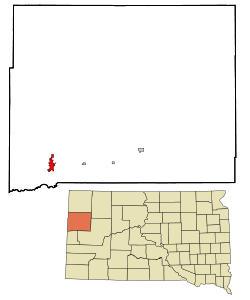Belle Fourche, SD
| Belle Fourche, South Dakota | |
|---|---|
| City | |

Business District of Belle Fourche
|
|
 Location in Butte County (top) and South Dakota (bottom) |
|
| Location in the United States | |
| Coordinates: 44°40′3″N 103°51′1″W / 44.66750°N 103.85028°WCoordinates: 44°40′3″N 103°51′1″W / 44.66750°N 103.85028°W | |
| Country | United States |
| State | South Dakota |
| County | Butte |
| Incorporated | 1903 |
| Government | |
| • Mayor | Gloria Landphere |
| Area | |
| • Total | 8.60 sq mi (22.27 km2) |
| • Land | 8.53 sq mi (22.09 km2) |
| • Water | 0.07 sq mi (0.18 km2) |
| Elevation | 3,022 ft (921 m) |
| Population (2010) | |
| • Total | 5,594 |
| • Estimate (2016) | 5,655 |
| • Density | 655.8/sq mi (253.2/km2) |
| Time zone | MST (UTC-7) |
| • Summer (DST) | MDT (UTC-6) |
| ZIP Code | 57717 |
| Area code(s) | 605 |
| FIPS code | 46-04380 |
| GNIS feature ID | 1265119 |
| Website | bellefourche.org |
Belle Fourche (/bɛlˈfuːʃ/; bel-FOOSH) is a city in and the county seat of Butte County, South Dakota, United States. The population was 5,594 at the 2010 census.
The city is near the geographic center of the 50 U.S. states.
Belle Fourche (French for "beautiful fork") was named by French explorers coming from New France, referring to the confluence of what is now known as the Belle Fourche and Redwater Rivers and the Hay Creek. Beaver trappers worked these rivers until the mid-19th century, and Belle Fourche became a well known fur trading rendezvous point. During and after the gold rush of 1876, farmers and ranchers alike settled in the fertile valleys, growing food for the miners and their work animals. At the same time, the open plains for hundred of miles in all directions were being filled by huge herds of Texas and Kansas cattle. Towns sprang up to serve the ever-changing needs of the farmers and ranchers. In 1884, the Marquis de Mores, a French nobleman and contemporary of Theodore Roosevelt, established a stagecoach line between Medora, North Dakota, and Deadwood, South Dakota. The Belle Fourche way station included a stage barn and a saloon.
Knowing the cattle barons and the railroad would need a point at which to load the herds of cattle onto freight cars for shipment to the packing plants in the Midwest, Seth Bullock provided a solution and became the parent, in effect, of Belle Fourche, the city. After serving in the Montana legislature in 1871–1873 (and being instrumental in the establishment of a National Park at Yellowstone), he had come to the Black Hills to cash in on selling supplies to the Deadwood miners, arriving August 2, 1876, the day Wild Bill Hickok was murdered.
...
Wikipedia

